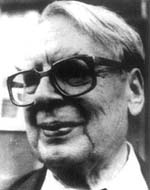Tales of Statisticians
Boris Gnedenko
1 Jan 1912 - 27 Dec 1995Boris Vladimirovich Gnedenko was born in Simbirsk to a family of Ukrainian origin. The family moved to Kazan when Boris was three. He was a brilliant pupil in Kazan, and the Soviet Minister of Education at that time, Lunacharskii, overruled official objections to permit him to enter the University of Saratov at fifteen. Ironically, in view of what was to follow, Gnedenko's motive for studying mathematics was that, as an abstract subject, it was beyond the understanding, and thus the probable interference, of the Communist bureaucracy. He graduated from Saratov after three years of study, and began teaching at the Textile Institute in Ivanovo, an industrial town east of Moscow.
A memory of those days may linger in this data set for the "number of stoppages, per hundred, of a weaving machine requiring attention by the weaver," in Gnedenko and Kninchin's ELementary Introduction to the Theory of Probability (p15):
Break in warp thread Break in woof thread Change in the shuttle Breakage of shuttlecock Other
The problems of reliability in textile machinery, together with visiting seminars led by Moscow professors Kolmogorov and Khinchin, led to Gnedenko's first publications in queuing theory (1933). In 1934 he entered Moscow State University, working at first under Khinchin, later under Kolmogorov. The problem he attacked was the limiting behavior of sums of independent random variables, when the number of terms grows without limit. After obtaining his PhD in 1937 for an original solution of this problem, he became a research assistant in the University's Mathematics Institute.
Then came the incident for which Gnedenko is now famous. On a hiking trip to the Caucusus with several Institute colleagues that summer, he let it be known in conversation that he was not enthusiastic about Soviet policies. Gnedenko was drafted into the army on 1 December, and four days later he was arrested by the KGB; he had been denounced by one of his companions on the hiking trip. He was imprisoned in intolerably crowded conditions, interrogated daily, and offered his release if he cooperated by identifying his teacher Kolmogorov as the leader of a group of "enemies of the people" in the Mathematics Institute. After six months of this, having steadfastly refused to even consider the possibility of complying, he was released with a "black mark" on his record. With support from Kolmogorov and Khinchin, he was eventually able to resume his position as a research assistant, in 1938.
His "black mark" made him ineligible for the army when Hitler attacked in 1941. He submitted his dissertation in 1941, and was awarded his degree in 1942. After the war, he was elected to the Ukrainian Academy of Sciences on Kolmogorov's recommendation; he left Moscow to become a professor at Lvov, where he met Banach and was tremendously impressed by him. In 1949 he became director of the Kiev Institute of Mathematics, where he organized and led the probability theory department. His and Kolmogorov's joint book, Limit Distributions for Sums of Independent Random Variables, based on his early researches, came out in that same year. A textbook, Course in Probability Theory, appeared in 1950. He continued his researches on summation theory, and (with his student Kovalenko) on nonparametric statistics.

In 1960 Gnedenko returned to Moscow State University as professor, later head, of the department of probability theory. In 1965 appeared Mathematical Methods in Reliability Theory (with Belyaev and Solovyev), and in 1966, his book on queuing theory (with Kovalenko). In addition to pursuing his own researches, and guiding the work of others, he took a strong interest in mathematics education in secondary schools, and produced a popular account of reliability (with Solovyev) in 1982, and an Introduction to Mathematics, aimed at the future professional, in 1991.
Gnedenko outlived the Soviet system. He also outlived his generation. He died in 1995, the last survivor of the great group of Russian Probabilists (Chebyshev, Markov, Lyapunov, Bernstein, Khinchin, Kolmogorov, and the less known Linnik). Until almost the day of his death, though ill and nearly blind, he continued to be mathematically active. Among other things, in his last years he organized a Department of Actuarial Mathematics at Moscow University.
His obituary by Vatutin et al (tr Theory of Probability and Applications, v41 [1997] #2) mentions, as something previously known only to a few close friends, his principled behavior under Sovietism. It deserves to be remembered as a practical refutation of the cynical enonometrist theories embodied in such supposed behavioral models as the Prisoner's Dilemma. We have accordingly designated principled human conduct as the G or Gnedenko Factor, and expect that future computations about humanity, including humanity under pressure, will allow for that factor.
Others, of course, will aim to destroy it; here is one of the great themes of human history.
4 Sept 2004 / Contact The Project / Exit to Resources Page